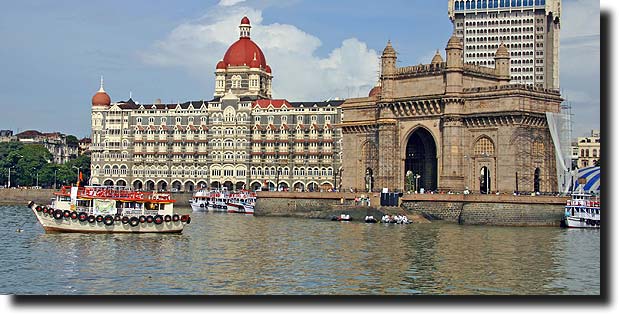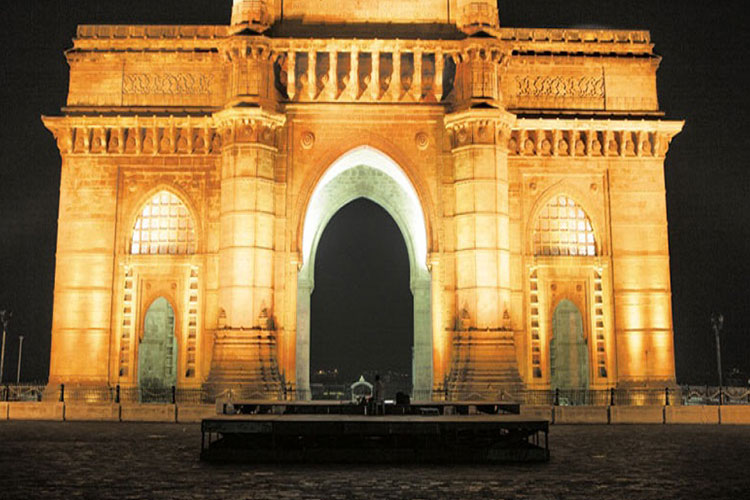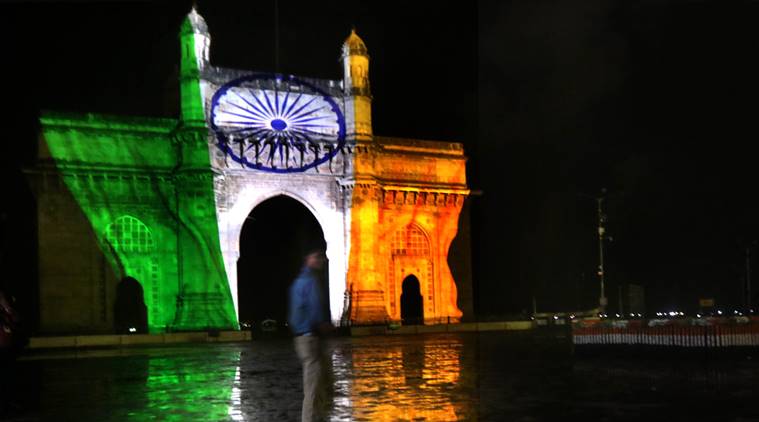The Gateway of India is an arch-monument built in the early twentieth century in the city of Mumbai, in the Indian state of Maharashtra. It was erected to commemorate the landing in December 1911 at Apollo Bunder, Mumbai (then Bombay) of King-Emperor George V and Queen-Empress Mary, the first British monarch to visit India. At the time of the royal visit, the gateway was not yet built, and a cardboard structure greeted the monarch. The foundation stone was laid in March 1913 for a monument built in the Indo-Saracenic style, incorporating elements of 16th-century Marathi architecture. The final design of the monument by architect George Wittet was sanctioned only in 1914, and construction was completed in 1924. The structure is a triumphal arch made of basalt, which is 26 metres (85 feet) high.
After its construction the gateway was used as a symbolic ceremonial entrance to British India for important colonial personnel. It has been called a symbol of "conquest and colonisation" commemorating British colonial legacy. The gateway is also the monument from where the last British troops left India in 1948, following Indian independence. It is located on the waterfront at an angle, opposite the Taj Mahal Palace and Tower Hotel and overlooks the Arabian Sea. Today, the monument is synonymous with the city of Mumbai, and is amongst its prime tourist attractions. The gateway is also a gathering spot for locals, street vendors, and photographers soliciting services. It holds significance for the local Jewish community as it has been the spot for Hanukkah celebrations, with the lighting of the menorah, since 2003. There are five jetties located at the gateway, of which two are used for commercial ferry operations.

The gateway was the site of a terror attack in August 2003, when there was a bomb blast in a taxi parked in front of it. Access to the gateway was restricted after people congregated at its premises following the 2008 Mumbai terror attacks, in which the Taj Hotel opposite the gateway and other locations in its vicinity were targeted.
In March 2019, the Maharashtra state government proposed a four-step plan to develop the location for the convenience of tourists, following a direction issued by the state governor in February 2019.
The gateway's arch has a height of 26 metres (85 feet) with its central dome being 15 metres (49 feet) in diameter. The monument is built of yellow basalt and reinforced concrete. The stones were sourced locally while the perforated screens were brought in from Gwalior. The monument faces towards the Mumbai Harbour.

There are four turrets on the structure of the gateway, and there are steps constructed behind the arch of the gateway which lead to the Arabian Sea. The monument features intricate stone latticework (also known as the jali work).
The Scottish architect, George Wittet combined elements of the Roman triumphal arch and 16th-century architecture of Gujarat. The architecture also combines indigenous architectural elements with elements of Islamic architecture, known as the Indo-Saracenic. The harbour front was realigned in order to make an esplanade, which would sweep down to the centre of the town.

On centre of the Town, Opposite to Taj Hotel
On each side of the arch, there are large halls with the capacity to hold 600 people. The cost of the construction was 21 lakhs (two million one hundred thousand rupees), borne by the then government. Due to a paucity of funds, the approach road was never built. Hence, the gateway stands at an angle to the road leading up to it.

The Beautiful Arch Monument
On each side of the arch, there are large halls with the capacity to hold 600 people. The cost of the construction was 21 lakhs (two million one hundred thousand rupees), borne by the then government. Due to a paucity of funds, the approach road was never built. Hence, the gaIn February 2019, Seagate Technology and CyArk embarked on a mission to digitally record and preserve the gateway, by digital scanning and archiving of the monument. The images and data collected will be used to make photo-real three dimensional models. This is a part of CyArk's international programme for digitally preserving heritage monuments. It involves aerial surveys conducted with terrestrial laser scanning (LiDAR), drones, and photogrammetry exercises. The drawings and three-dimensional models will inform any future reconstruction works.teway stands at an angle to the road leading up to it.
The gateway was built to commemorate the arrival of George V, Emperor of India and Mary of Teck, Empress consort, in India at Apollo Bunder, Mumbai (then Bombay) on 2 December 1911 prior to the Delhi Durbar of 1911; it was the first visit of a British monarch to India. However, they only got to see a cardboard model of the monument, as construction did not begin until 1915. The foundation stone for the gateway was laid on 31 March 1913 by then governor of Bombay, Sir George Sydenham Clarke with the final design of George Wittet for the gateway sanctioned in August 1914.

Before the gateway's construction, Apollo Bunder used to serve a native fishing ground. Between 1915 and 1919 work continued at the Apollo Bunder to reclaim the land on which the gateway was to be built, along with the construction of a sea wall. Gammon India had undertaken construction work for the gateway. Its foundations were completed in 1920 while construction was finished in 1924. The gateway was opened to the public on 4 December 1924 by then viceroy, Rufus Isaacs, 1st Marquess of Reading. Following Indian independence, the last British troops to leave India, the First Battalion of the Somerset Light Infantry, passed through the gateway with a 21-gun salute, as part of a ceremony on 28 February 1948, signalling the end of the British Raj.

N. Kamala, professor at Jawaharlal Nehru University, refers to the gateway as a "jewel in the crown" and a "symbol of conquest and colonisation". The monument commemorates the legacy of British colonial rule, namely the first visit of a British monarch to India and its use as an entry point for prominent colonial personnel into British India. Today the gateway is synonymous with the city of Mumbai. Since its construction, the gateway has remained amongst the first structures visible to visitors arriving in Bombay by the sea.

The Gate Way Of India On Independence Day
Since 2003, the gateway has been the location for the local Jewish community to light the menorah for Hanukkah celebrations every year. This ritual was started by Rabbi Gavriel Noach Holtzberg of the chabad in Mumbai (located in Nariman House). It also became a site for prayers following the 2008 Mumbai terror attacks which targeted, amongst others, Nariman House.
